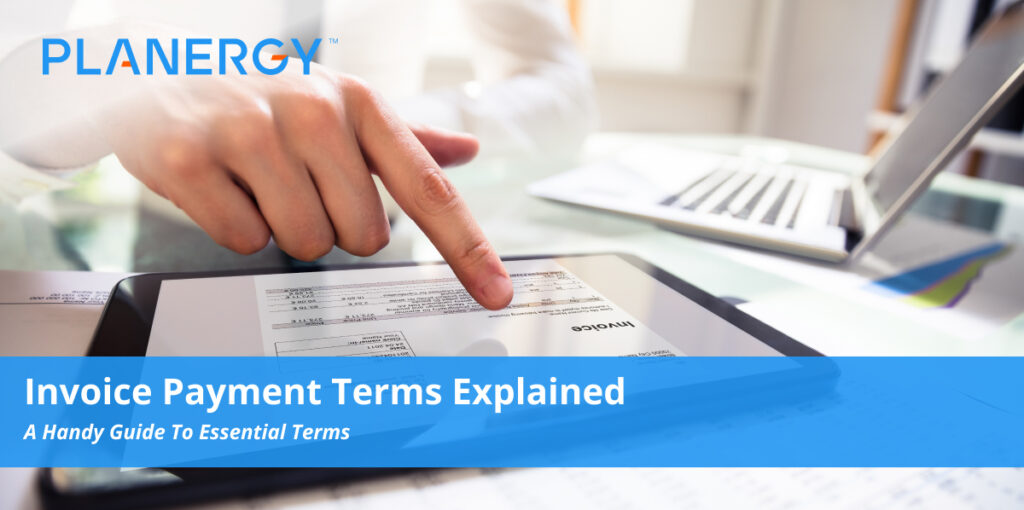Big or small, every business needs to get paid to stay alive. And whether you’re a small business owner or part of a large procurement and accounts team, getting paid means sending invoices and keeping cash flowing into your coffers on a reasonable schedule.
For many business owners, however, invoicing workflows—particularly with regard to invoicing payment terms—may not be as well-optimized as they could be, resulting in slow payments, disgruntled clients, or even lost value. Understanding the most common payment terms, and how best to apply them when communicating your expectations to clients, is key to ensuring you get paid on time and without risking your cash flow, your bottom line, or client satisfaction.
Invoice Payment Terms: What Are They?
Invoices represent an agreement between two parties: you, as the issuing party, have provided goods or services to the buyer (your customer), from whom you now expect payment, as initially agreed upon via purchase order or other means.
That’s the invoicing process in a nutshell. Simple, right?
On the surface, yes. The challenge for anyone who’s invoicing another party—whether they’re a seasoned hand working for a megacorporation or a small business owner wearing their accounts receivable hat for the day—is effectively and accurately using invoice payment terms to communicate essential information to the recipient, including:
- Payment due date.
- The payment method (or payment methods) you accept, e.g. cash, credit cards, debit cards, certified check, etc.
- Late fees (also known as late payment fees) and any other penalties associated with incomplete, erroneous, or late payments.
- Any incentives you provide for early payment (discounts, free shipping on orders that meet certain requirements, etc.)
- Any other terms specific to your agreement with that client.
Clearly defining payment terms and making them a standard part of your invoicing process, you’ll reduce or eliminate the potential for miscommunications and misunderstandings with clients—two things you definitely want to avoid if you want to build and maintain strong client relationships.
Why Understanding Invoice Payment Terms Matters
Your client wants your goods and services. You want to be paid. Unfortunately, unclear, incomplete, or absent payment terms can make it harder for you to get the cash you need, when you need it.
Clearly defining payment terms and making them a standard part of your invoicing process, you’ll reduce or eliminate the potential for miscommunications and misunderstandings with clients—two things you definitely want to avoid if you want to build and maintain strong client relationships.
This is especially important for small businesses who may not have access to large sources of credit or additional revenue streams that can keep them afloat while dealing with late payments. Those same small business owners may also be reluctant to indulge in credit—if it is available—because the potential long-term risk to their company’s financial health may outweigh the immediate reward. In addition, the fear of damaging their reputations with clients while they’re just starting out may motivate some business owners to simply endure late or inaccurate payments to keep the wolf from the door.
Ultimately, however, understanding and conveying payment terms in the clearest and most concise way possible is much more advisable. It improves client relationships by putting everyone on the same page from the get-go, reduces unnecessary back-and-forth to iron out the details, and protects your cash flow by reducing or eliminating late payments.
Common Invoice Payment Terms
While they are largely concerned with When (number of days to pay), Where (the destination for payment), Why (particulars of the goods and services delivered), and How (preferred method of payment), specific invoice payment terms help shed light on the particulars:
Cash Account: This term is used on invoices that must be paid in cash or the equivalent, with no credit issued or accepted.
Cash Before Shipment (CBS): Useful for businesses that create custom work to spec (e.g., furniture makers, artists, designers, etc.). Indicates a down payment is required before the goods are created and shipped. Mitigates risk of loss for the creator.
Cash in Advance (CIA): Similar to CBS. Full payment must be cleared before work begins.
Cash Next Delivery (CND): Useful for businesses whose customers place recurring orders. Indicates that the current order must be paid off in full before the next scheduled delivery. Also called recurring invoices or recurring invoicing.
Cash on Delivery (COD): Payment is due, in cash or the equivalent, when the invoice is received.
Cash with Order (CWO): Similar to CBS, but requires payment of the entire amount due upfront, prior to goods creation and order fulfillment.
Contra/Contra Payment: When the party issuing the invoice also owes money to the party being invoiced, the company owing the larger total sum pays the difference between the two amounts owed to square the debt.
End of Month (EOM): Payment is due on the last day of the month containing the invoice date.
Immediate: Payment is due when the invoice is received. Synonymous with COD.
Interest Invoice: A special invoice issued for interest and late fees accrued on unpaid invoices. May have its own terms separate from the original invoice, as established in your overarching payment terms provided to clients.
Line of Credit Pay: Provides the buyer with the opportunity to settle all outstanding invoices accrued within a given period at once—most often monthly or quarterly. Also called service on credit. Because extending credit and delaying payment in this way can hamper cash flow and create additional risk exposure, this method is more common with large companies than small businesses and freelancers.
Month Following Invoice (MFI): Payment is due
Net 7: Payment is due within 7 days of the invoice date.
Net 10: Payment is due within 10 days of the invoice date.
Net 30: Payment is due within 30 days of the invoice date.
Net 60: Payment is due within 60 days of the invoice date.
Net 90: Payment is due within 90 days of the invoice date.
Payable on Receipt: Synonymous with “Immediate.”
Payment in Advance (PIA): Used for deposits or down payments. May require full prepayment or only a specific portion of the overall invoice amount.
Terms of Sale: The particulars of the order being invoiced. Includes:
- Total cost of the order.
- Quantity and quality of goods provided.
- Delivery date.
- Due Date.
- Accepted payment methods.
X% 10 Net XX: A formula used to provide incentive for early payment. For example, 3% Net 30 would indicate the buyer will receive a 3% discount if the amount owed is paid in full within 10 days of receiving the invoice; otherwise, the full amount is due within 30 days of the invoice date.
Putting Invoice Payment Terms to Work
Once you know how to frame your invoice for maximum clarity and compatibility with your workflows, you can further refine your approach to invoicing for optimal efficiency, accuracy, and speed.
Keep these quick tips in mind when it’s time to get paid:
Focus on the Three Cs. Clarity, Conciseness, and Correctness. These three Cs should be your guiding lights in laying out your invoicing terms and (overall invoicing process). Invoices that make the particulars crystal clear, without beating around the bush, and always have the correct information, will produce much better results than endless back-and-forth with confused clients arguing over unclear due dates, duplicate invoices, or incorrect information.
Modernize. Paper-based invoicing and snail-mail payments don’t exactly lend themselves to a sprightly, responsive competitive profile in the age of digital transformation. If possible, be sure to support payment methods that offer maximum convenience, and minimal hassle, to your customers, including credit cards, automated clearing house (ACH), etc.
In addition, eInvoicing with a comprehensive invoice automation system lets you eliminate the waste and delay of paper entirely, and makes it much more likely any invoice with X% 10 Net XX or Immediate payment terms will be paid on time or early. And if you choose a cloud-based, artificial-intelligence-driven solution like Planergy, you can increase accuracy, speed, and efficiency even further with process automation. Automatic data population, client payment reminders, and fraud protection are just some of the ways such a software package can help you improve your invoice processing cycle.
Weigh discounts and penalties carefully. Discounts can bring in additional business, improve your customer relationships, and build loyalty while encouraging early or on-time payments. But like penalties—which can also encourage speedier payment, at the cost of client happiness—they’re best used both sparingly and strategically to keep clients from becoming inured to their powers.
Invoice with Confidence
Without proper invoice payment terms, trying to get what you’re due, when you need it, is more a wish than a plan. Take the time to establish the terms that work best for your business with regard to cash flow and operations while preserving important client relationships. Open communication, realistic expectations, and a collaborative approach will go a long way toward ensuring your business is paid on time, your cash flow is reliable, and your business relationships and reputation are rock-solid.




